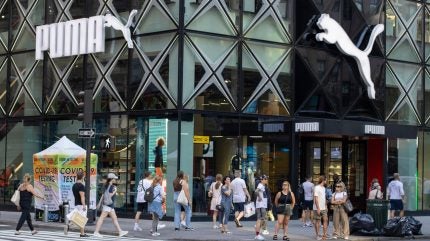
Puma said in its preliminary results for the second quarter (Q2) currency-adjusted sales growth for the year is “no longer” projected to meet previous expectations following a 2.0% decrease in second-quarter sales to €1.94bn ($2.28bn).
This downturn was driven by 9.1% sales drop in North America, 3.9% in Europe and 3.9% in Greater China.

Discover B2B Marketing That Performs
Combine business intelligence and editorial excellence to reach engaged professionals across 36 leading media platforms.
“Softer than anticipated topline development in our key markets (North America, Europe and Greater China) affected Puma’s sales and earnings performance in the second quarter,” the company stated.
Over the quarter, Puma’s wholesale channels experienced a 6.3% decline, while direct-to-consumer sales saw a 9.2% increase, bolstered by significant e-commerce growth.
Puma’s key results in Q2 FY25
Puma’s gross profit margin saw a reduction of 70 basis points, settling at 46.1%, largely due to increased promotional activities and negative currency exchange impacts.
However, this decline was somewhat mitigated by improvements in sourcing and freight costs, along with benefits arising from a better mix in distribution channels.

US Tariffs are shifting - will you react or anticipate?
Don’t let policy changes catch you off guard. Stay proactive with real-time data and expert analysis.
By GlobalDataThe company’s adjusted earnings before interest and taxes (EBIT) for the second quarter, which excludes one-off expenses, fell to a loss of €13.2m. The primary factors contributing to this decrease were the overall weaker sales performance and a diminished gross profit margin.
In the same period, Puma faced one-time charges amounting to €84.6m and income taxes incurred by the company totalled a loss of €94.7m, an increase from the previous year mainly due to the write-off of deferred tax assets in the US and China.
Consequently, Puma reported a net loss of €247.0m for the quarter.
Puma’s performance for first half of FY25
In the year to date, there was a currency-adjusted sales drop of 1.0% to €4.02bn, which translates to a 4.8% decrease on a reported basis.
The company’s gross profit margin contracted by 60 basis points, landing at 46.5%.
When one-time costs are excluded, the adjusted earnings before interest and taxes (EBIT) fell to €62.5m.
Within this period, Puma faced one-time expenses amounting to €102.6m, contributing to a net loss of €246.6m.
The company’s inventory levels escalated by 9.7% on a reported basis and by 18.3% when adjusted for currency effects, reaching €2.15bn, primarily due to increased stock volumes in crucial markets.
Puma plans to actively manage inventory levels despite anticipated challenges including US Tariffs which are projected to have an approximate €80m negative effect on gross profit for the year.
Puma’s full year 2025 outlook
Puma has revised its full-year guidance for 2025 with currency-adjusted sales now expected to show a low double-digit percentage decrease, compared to the previously anticipated low- to mid-single-digit percentage increase.
The company now forecasts a full-year EBIT loss for 2025 due to softer sales trends, increased currency pressures, US tariff impacts, and additional cost-alignment measures including one-off charges planned for the latter half of the year.
Capital expenditure estimates have also been reduced from around €300m to approximately €250m for 2025 considering these revised expectations.
In April this year, Puma named former Adidas sales head Arthur Hoeld as its new management board chairman and chief executive officer (CEO) to lead its company growth.





